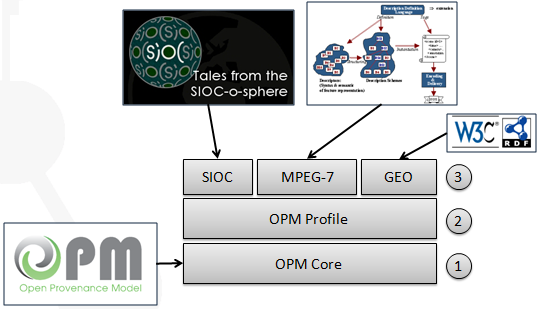Models
Provenance has become a necessity in a wide range of social and scientific applications, in particular, in news and
blogs scenarios, where it is key to determine the sources of the published information, the process that led to a publication
or the references used, in order to generate a trust value for the information.
This network has been developed following the NeOn methodology ,
by reusing existing ontologies and vocabularies and taking into account the work and requirements done by the W3C provenance Incubator Group
in the News Aggregator Scenario. 
The first level (block 1) consists on the OPM Ontology (OPMO) which is domain independent provenance model on top of which
we build our profile (block 2), extending and adapting the core to our scenario. Finally, on top of the profile we reuse domain-specific vocabularies (SIOC, MPEG-7, W3C GEO)(block 3),
to model the descriptive metadata of the artifacts.
Open Provenance ModelOPM proposes a causal graph, where the nodes are either artifacts (immutable pieces of state), processes (action or series of actions performed on artifacts), or agents (controllers of processes); and the edges represent the causal relationships between the nodes: Used (a process used some artifact), WasControlledBy (an agent controlled some process), WasTriggeredBy (a process activated other process), WasGeneratedBy (a process generated an artifact) and WasDerivedFrom (an artifact was derived from another artifact). It also has the notion of accounts (partial subgraphs of the provenance graph), which are useful to represent multiple views of the same graph from different perspectives; and roles, which allow describing deeper some of the aforementioned causal relationships.
Two ontological approaches exist to model OPM: OPM Ontology(OPMO) and
OPM Vocabulary (OPMV). The former is more complex and consists
on an ontology that models the edges as an n-ary relationship pattern, while the latter is a lightweight ontology to assert the OPM concepts.
OPMO is the one used to model the proposed scenario, because it allows adding extra metadata to the edges instead of having to use reification.

SIOC OntologySIOC is an ontology designed to describe information from online communities (such as blogs or forums), and it is used with OPM in the blogging platform. SIOC fits perfectly for this task, since it was designed for this purpose. It has Containers, Items and Posts to model the posting activity in the blogs, tracks the followers and subscribers of a user and can even deal with different versions of a post (pointing to previous versions). It also models the comments of a post, the RSS feeds or belonging to a group and links some of these relationships to other popular vocabularies such as FOAF (Friend of a friend) or DC (Dublin Core) . It is a resource-centric vocabulary centered in the domain of online communities. MPEG-7 OntologyThe MPEG-7 ontology is a transformation of the MPEG-7 standard into OWL-Full, allowing descriptions on every detail of an image, video or audio file: size, duration, color, decomposition in segments, etc. It has been used in our scenario to annotate the metadata of part of the contents provided by the users (the ones which refer to images or video). WGS84 VocabularyThis simple ontology is used for describing the location of spatial things in coordinates (latitude, longitude and height) and places (Madrid, Barcelona, Ireland, etc). According to the specification, a spatial thing is "Anything with spatial extent", so we have included in that definition the edges of the OPM graph. WebN+1 ontology for the tourist domainThis ontology which has been implemented using OWL, models the tourist domain represented in the WebN+1 platform. The ontology is based on the ontología Infutur, as it fulfils most of the domain requirements of the "El Viajero" use case defined in the project. At the same time, the Infutur ontology reuses several ontologies, such as SIOC (for the specification of users), W3C Geo (for the specification of geographical data), FOAF (for the specification of information about people), RECO (for representing information for recommendations) or Review (for representing reviews and ratings). The main elements of the ontology of the tourist use case of the WebN+1 project include classes and properties for representing tourist attractions (TourismResource), accommodation (Accommodation), multimedia content (Image, Audio), the location of resources (SpatialThing), the users of the system (UserAccount, Profile, Preferences), recommendations (Recommendation) and different organisations. |
|

